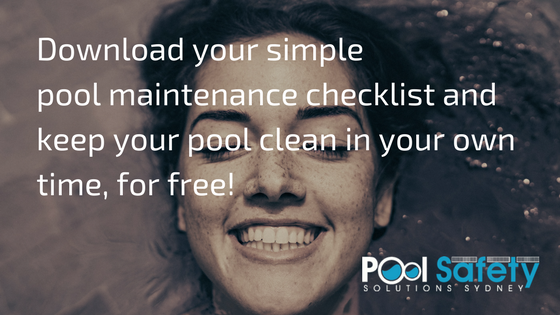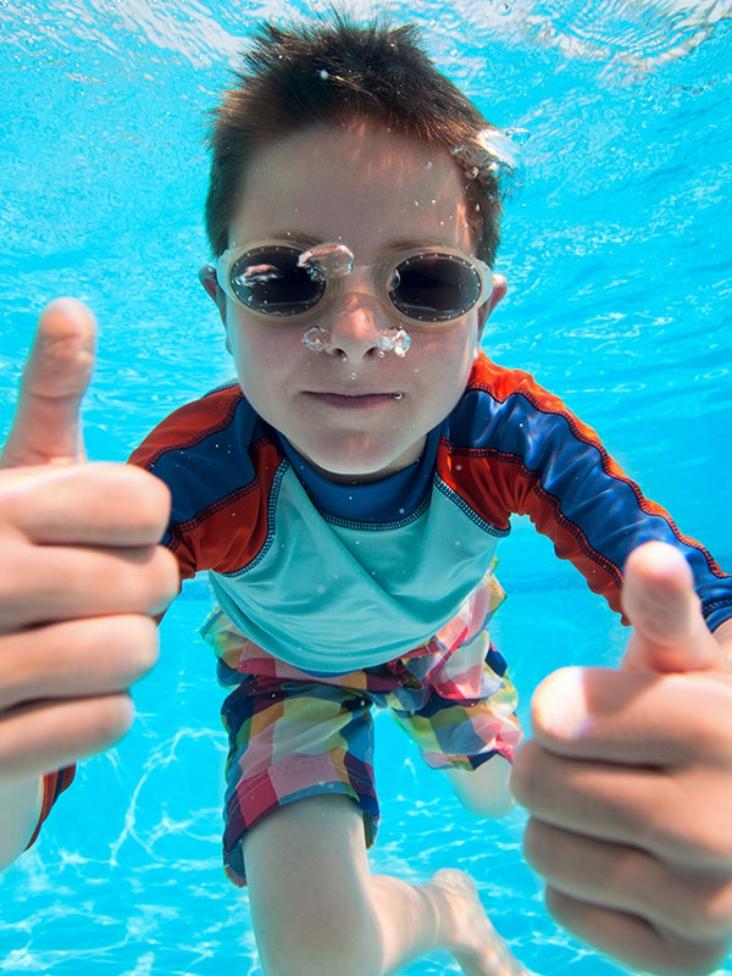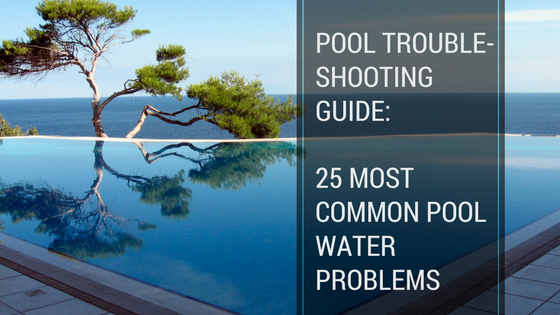You’ll love learning about these 25 common, but annoying, pool water problems with a user-friendly, step-by-step troubleshooting pools guide
I think you’ll agree with me when I say:
Owning a pool is great, but troubshooting specific pool water problems can be a HUGE pain and costly exercise.
Or is it?
Well, it turns out, you can potentially save yourself loads in time, money and frustration…
… just by taking a few simple steps to diagnose and treat common pool water problems, before calling in the professionals.
In today’s post, I’m going to share a comprehensive pool water troubleshooting guide you can use instantly, so you can handle common issues yourself.
To start things off, we’ll go over a few common problems related to algae and other growth.
Simply use the subheadings to find the description that best fits your pool water’s appearance.

Murky, green water (with some growth)
Culprit: Green Algae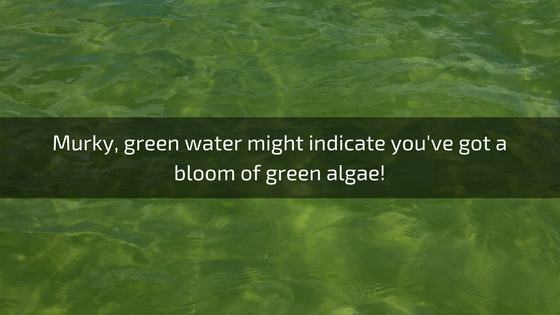
Causes
You may experience a bloom of green algae if:
– Your pool is low on sanitiser levels
– Your pool has been poorly maintained
– You have a improper water imbalance
– Your pool system has low circulation/poor water flow
How do I fix green algae?
You can try:
– Using a shock treatment
– Algaecide
– Clean the pool filter
– Do a thorough check over all components of your pool system
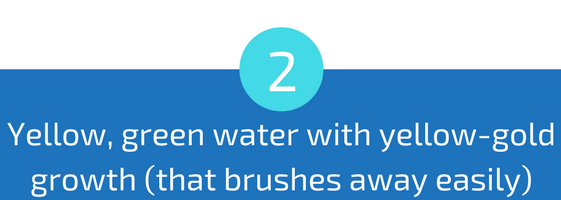
Yellow, green water with yellow-gold growth (that brushes away easily)
Culprit: Mustard Algae 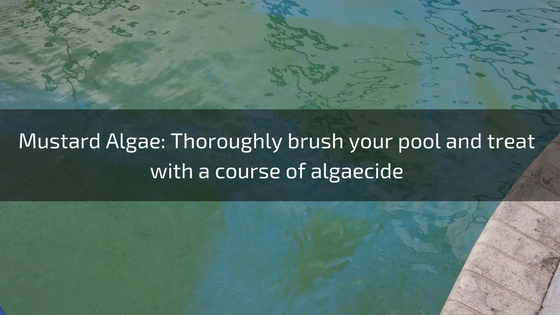
Causes
You may experience a bloom of mustard algae if:
– Your pool is low on sanitiser levels
– Your pool has been poorly maintained
– You have a improper water imbalance
– Your pool system has low circulation/poor water flow
How do I fix mustard algae?
You can try:
– Thoroughly brushing your pool
– Algaecide
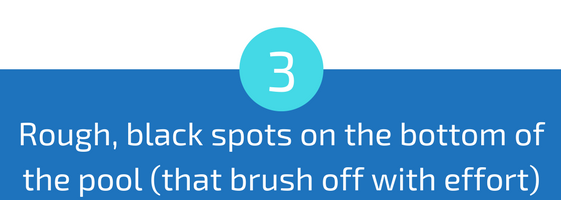
Rough, black spots on the bottom of the pool (that brush off with effort)
Culprit: Black Algae (AKA Black-spot Algae) 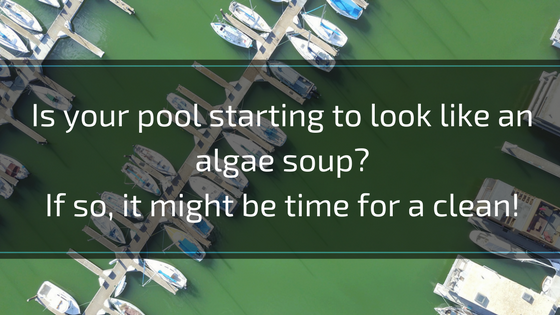
Causes
You may experience a bloom of mustard algae if:
– Your pool is low on sanitiser levels
– Your pool has been poorly maintained
– You have a improper water imbalance
– Your pool system has low circulation/poor water flow
How do I fix black algae?
You can try:
– Thoroughly brushing your pool
– Algaecide
– Clean the pool filter
– Do a thorough check over all components of your pool system

Pink, slimy bacterial growth (brushes off easily)
Culprit: Pink Slime
Causes
You may experience a case of pink slime if:
– Your pool is low on sanitiser levels
– Your pool has been poorly maintained
– You have a improper water imbalance
– Your pool system has low circulation/poor water flow
How do I treat pink slime?
You can try:
– Thoroughly brushing your pool
– Algaecide
– Clean the pool filter
– Do a thorough check over all components of your pool system

White mucous or tissue paper-like substance
Culprit: White mould
Causes
You may experience a breakout of white mould if:
– Your pool is low on sanitiser levels
– Your pool has been poorly maintained
– You have a improper water imbalance
– Your pool system has low circulation/poor water flow
How do I fix white mould?
You can try:
– Using a shock treatment
– Algaecide
– Clean the pool filter
– Do a thorough check over all components of your pool system
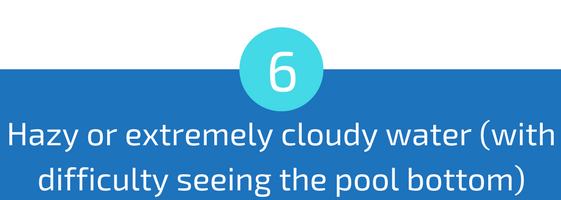
Hazy or extremely cloudy water (with difficulty seeing the pool bottom)
Culprit: Cloudy Water 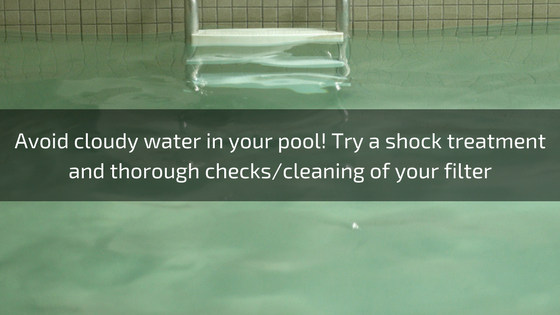
Causes
You may experience a bout of cloudy water if:
– Your pool is low on sanitiser levels or chloramines
– Your pool filter is not filtering the water properly
– You have a improper water imbalance
– Your pool system has low circulation/poor water flow
– There is particulate matter in your pool water
How do I fix cloudy water?
You can try:
– Using a shock treatment
– Algaecide
– Clean the pool filter and pump, and run continuously
– Do a thorough check over all components of your pool system
– Balance the water
Now if your water is discoloured, without visible signs of growth, you’ll also want to thoroughly check over the next step.

Grey, clear green or turquoise water
Culprit: Copper imbalance 
Causes
You may notice that your pool water has changed colour due to a copper imbalance.
This is usually caused by:
– Equipment corrosion
– Contamination from external sources
– Recent water changes
– Copper based algaecides
How do I fix water discolouration due to copper?
You can try:
– Use a metal remover (You can try Zodiac’s Metal Remover for a quality Aussie made product)
– Discontinue use of metal based algaecide
– Treat with non-metal based algaecide

Coffee brown or purple water
Culprit: Manganese imbalance 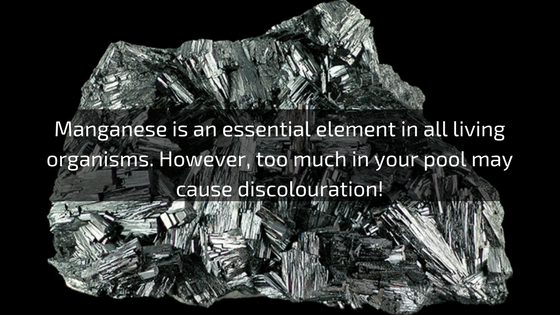
Causes
You may notice that your pool water has changed colour due to a copper imbalance.
This is usually caused by:
– Equipment corrosion
– Contamination from external sources
– Recent water changes
How do I fix water discolouration due to manganese?
You can try:
– Use a high potency liquid flocculant (You can grab a bottle of Super Floc from Bunnings)
– Use a metal remover (You can try Zodiac’s Metal Remover for a quality Aussie made product)
– Vacuum out waste
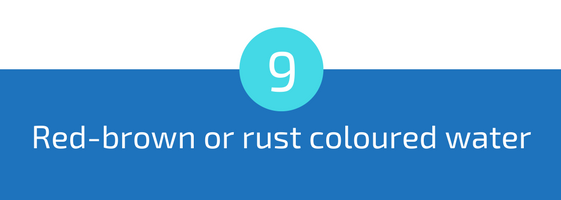
Red-brown or rust coloured water
Culprit: Iron imbalance 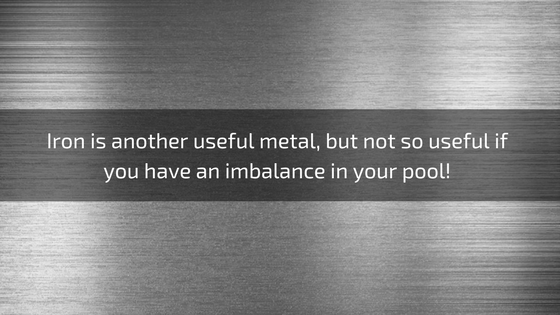
Causes
You may notice that your pool water has changed colour due to a iron imbalance.
This is usually caused by:
– Contamination from external sources
– Recent water changes
How do I fix water discolouration due to manganese?
You can try:
– Use a high potency liquid flocculant (You can grab a bottle of Super Floc from Bunnings)
– Use a metal remover (You can try Zodiac’s Metal Remover for a quality Aussie made product)
– Vacuum out waste
If you’ve noticed surface problems, the next steps may get you out of trouble!
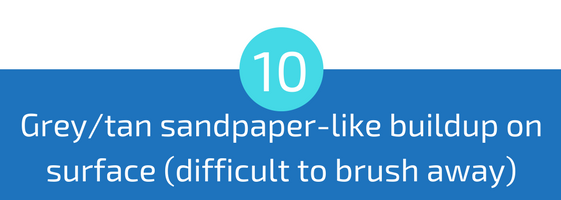
Sandpaper-like buildup on the surface (Grayish or tan colour that is difficult to brush away)
Culprit: Scale build up 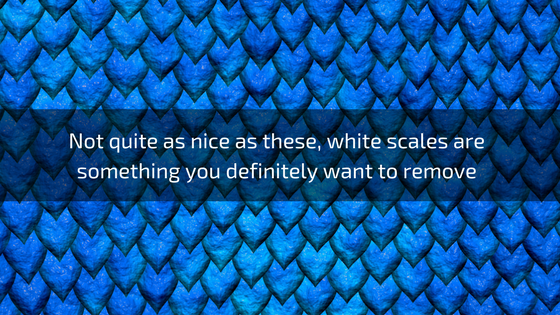
Causes
You may notice that your pool water has a slight grey-tan discolouration that is difficult to brush away, with a sandpaper-like build up on the surface.
This is usually caused by:
– Improper water balance where there is high total alkalinity (TA) pH
– Calcium hardness
How do I remove scale build up in my pool?
You can try:
– Use a high potency liquid flocculant (You can grab a bottle of Super Floc from Bunnings)
– Use a metal remover (You can try Zodiac’s Metal Remover for a quality Aussie made product)
– Balance your water pH
– Do a thorough acid wash of your pool

Pitting of plaster surfaces
Culprit: Etching
Causes
You may notice that your pool surface has started pitting on plastered surfaces.
This is usually caused by:
– Improper water balance where there is high total alkalinity (TA) pH
– Calcium hardness
How do I fix etching on my pool surface?
You can try:
– Balance your water pH
– Re-plaster the damaged and surrounding surfaces

Wrinkles in vinyl liner
Culprit: Liner wrinkling 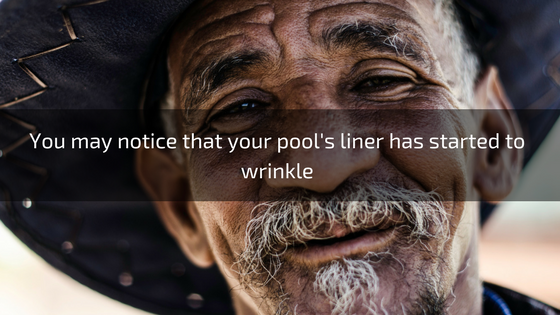
Causes
You may notice that your pool’s liner has started to wrinkle.
This is usually caused by:
– Improper water balance where there is high total alkalinity (TA) pH
– Calcium hardness
How do I fix wrinkles in my pool vinyl liner?
You can try:
– Balance your water pH
– Replace the vinyl liner if necessary

Pale to white, spotty discolouration on the surface
Culprit: Bleaching 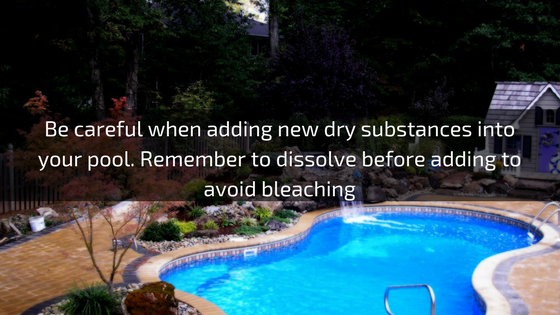
Causes
You may notice that your pool surface has developed a pale to white, spotty discolourationg on its surface.
This is usually caused by:
– Improper chemical addition
How do I fix bleaching damage in my pool?
You can try:
– Dissolve dry pool substances before adding it to your pool
– Replace the liner if necessary
– Repaint/restore surface
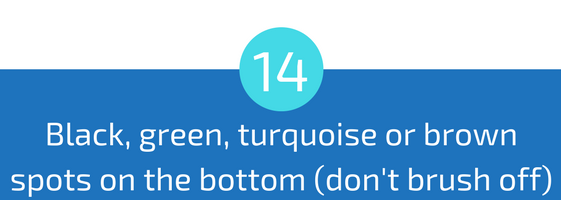
Black, green, turquoise or brown spots on the bottom (that do not brush off)
Culprit: Staining 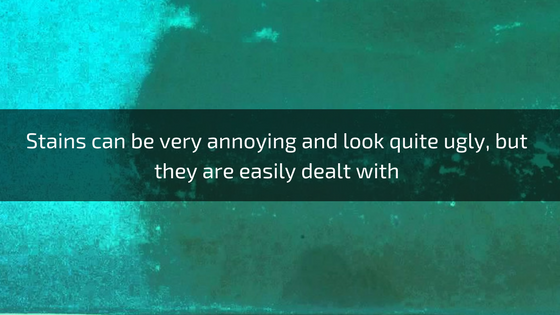
Causes
You may notice that your pool surface has developed black, green, turqoise or brown spots on the bottom, which do not brush off.
This is usually caused by:
– Stains from metal equipment or objects
– Fungal growth under the liner
– A build up of tannic acid
– Stains from leaves and other falling debris
How do I remove stains in my pool?
You can try:
– A stain remover (You can try this All-in-one Stain Remover from Zodiac)
– Use a metal remover (You can try Zodiac’s Metal Remover for a quality Aussie made product)
– Remove the liner and thoroughly clean its underside
– Conduct a shock treatment
If you’ve tried testing your pool water, and you’re having some trouble, the next two steps are what you’re after.

Colour of test fades to clear
Culprit: Bleaching of reagent 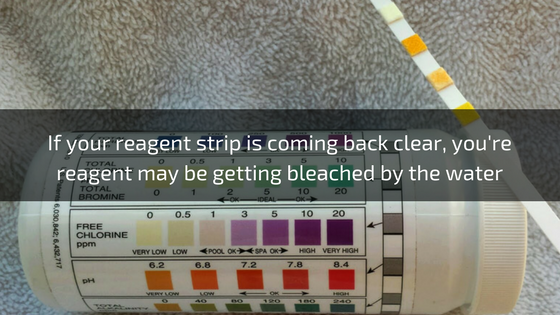
Causes
You may notice that your reagent test has faded to a clear colour, instead of displaying an accurate reading.
This is usually caused by:
– High levels of chlorine or bromine
How do I fix a clear reagent testing strip?
You can try:
– Adding up to 5 drops of a chlorine neutraliser

Reagent color is different than it should be (e.g. the pH test turns purple)
Culprit: Reagent discolouration 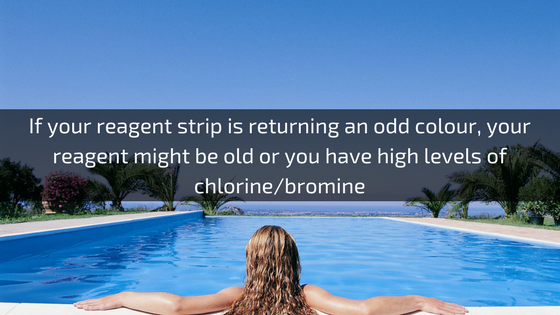
Causes
You may notice that your reagent test is turning into a different colour, instead of displaying an accurate reading.
This is usually caused by:
– High levels of chlorine or bromine
– Old or expired reagents
How do I fix a clear reagent testing strip?
You can try:
– Neutralise chlorine levels, then retest
– Replace old reagents, then retest
Now if you’ve gone through different water appearances, surface problems and testing issues check out the miscallaneous common problems your neighbours are facing too!
Have you noticed:
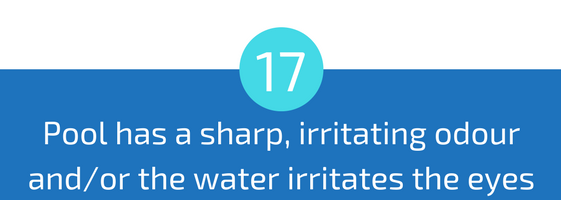
Pool has a sharp, irritating odour and/or the water irritates the eyes
Culprit: Odour and/or eye irritation 
Causes
You may notice that your pool water has a sharp, foul odour or that your eyes are unusually irritated after having a dip.
This is usually caused by:
– Imbalance of chloramines
– Swimmer waste, oils and organic waste
How do I remove foul odours and irritating pool water?
You can try:
– A Shock treatment

Short filter runs or a clogged filter
Culprit: Filtration problems 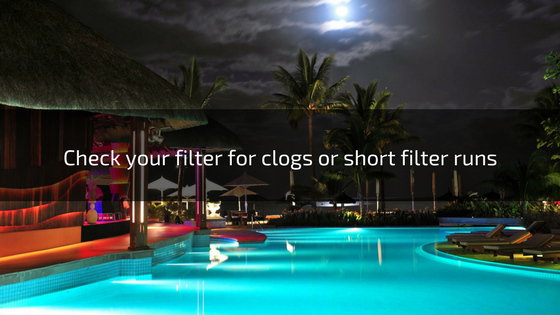
Causes
You may notice that your filter is consistently clogging up or that the runs it usually does have become shorter.
This is usually caused by:
– A dirty filter
– Filter media has remained uncleaned
– Improper filter media amount
– Water is not balanced
How do I unclog my pool filter?
You can try:
– Replace the filter media
– Clean the filter thoroughly

Unable to maintain the free chlorine level or cannot break the high combined chlorine
Culprit: Chlorine demand issues
Causes
You may notice that your free chlorine level is unstable or you cannot break the high combined chlorine.
This is usually caused by:
– Foreign contaminants from nearby environment
– Poor maintenance of your pool water
How do I resolve chlorine demand issues in my pool water?
You can try:
– Running a shock treatment

Bubbles on pool water surface
Culprit: Foaming water
Causes
You may notice that bubbles forming on your pool surface.
This is usually caused by:
– Excessive algaecide use
– Foreign contaminants
How do I resolve chlorine demand issues in my pool water?
You can try:
– Use a de-foamer ( You can try this No Foam De-Foamer)
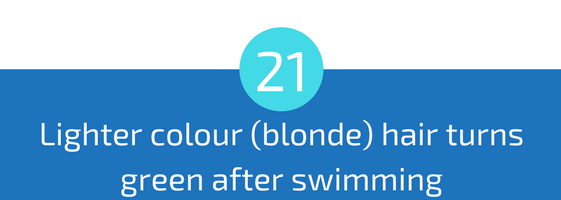
Lighter hair colours (blonde) hair turns green after swimming
Culprit: Green hair due to copper imbalance 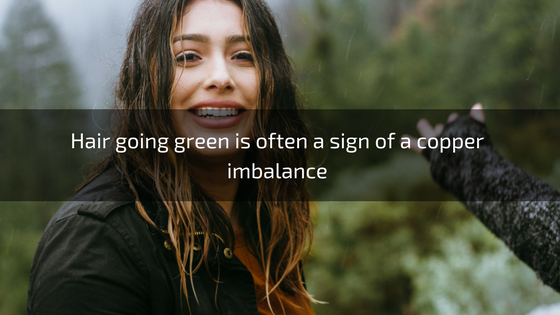
Causes
You may notice that lighter coloured hair turns green after coming out of the swimming pool.
This is usually caused by:
– Copper imbalance, usually resulting from:
– Equipment corrosion
– Contamination from external sources
– Recent water changes
– Copper based algaecides
How do I stop getting green hair after swimming?
You can try:
– Use a metal remover (You can try Zodiac’s Metal Remover for a quality Aussie made product)
– Use a bit of lemon juice or vinegar to rinse the hair, which will remove discolouration

Increased sanitiser demand (due to rain)
Culprit: Heavy rains washing debris and particulates into your pool water, increasing sanitiser demand
Causes
You may notice that excessive debris in your pool and other symptoms associated with sanitiser deficiency.
This is usually caused by:
– Rain
How do I bring swimming pools sanitiser demand back to normal?
Unfortuntely, you can’t do much to stop the rain from happening, however you can try:
– Rebalance the pool water after circulating the it for 24 hours
– Shock the pool

Noticeable change in water level
Culprit: Water loss 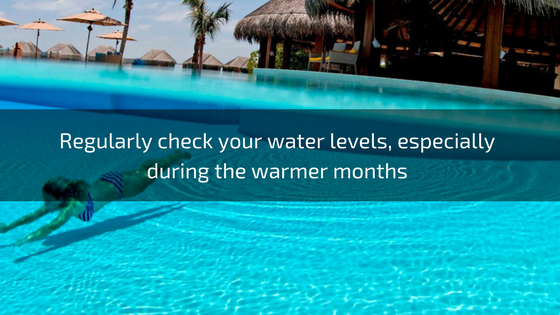
Causes
You may notice that the volume of your pool water changing.
If your pool water drops:
- 12 mm or less per day
- This may be caused by evaporation
- 12 mm to 25 mm per day
- This may be due to the pools active bather load (user load on the pool)
- 25 mm or more per day
- This could be from a leak in your pool. Consult professional advice IMMEDIATELY
How can I prevent water loss in my swimming pool?
You can try:
– Use a solar cover of water loss under 25 mm per day, and see if there is any improvement
– If no improvement, or you are experiencing more than 25 mm of loss per day, you need to contact a professional immediately

Insects, water birds, frogs etc
Culprit: Animals and insects 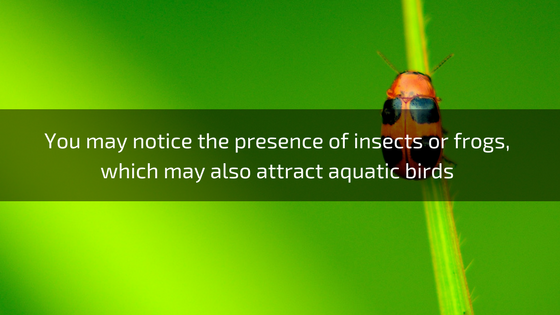
Causes
You may notice the presence of insects or frogs, which may also attract aquatic birds.
This is caused by:
– Environmental factors
– Poor water quality
How can I prevent animals and insects from visiting my swimming pool?
You can try:
– Shock treatment to kill organic particulates
– Treat your pool with an algaecide

Birds Dropping Poop in your Pool
Culprit: Birds 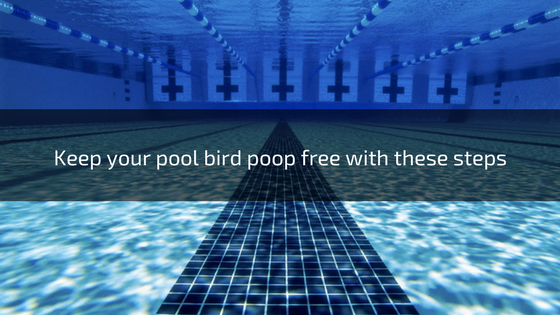
Most pool owners have asked themselves:
“How do I keep birds away from my swimming pool?”
Bird droppings in your swimming pool aren’t just unhygienic, but it will also cause your water to “fowl” up much faster, and “dump” your water quality.
If only it were as easy as using poorly constructed bird poop related puns.
Then thousands of pool owners wouldn’t be spending their hard earned money keeping their pools free of bird droppings.
We’ve done some research and found a couple of brilliant proven ways to keep those pesky birds from leaving their business in your pool.
Oh, it get’s better:
You won’t harm any birds in the process.
Causes
This problem will usually intensify over the warmer months of the year, when birds and their young are generally more active.
In some species of birds, the parent birds will scoop up their chicks’ faeces and fly it away from their nest.
This is so predators are not alerted of the nest’s presence.
Why they choose to poop and drop their youngs’ droppings in your pool may have something to do with hiding the scent far from the nest.
Here’s how you can keep birds from dropping poop in your pool:
Place a few rubber snakes around your pool
A quick fix and simple method for keeping those birds from coming near your pool area is to head down to your local dollar store and pick up a few rubber snakes.
Simply place the snakes around your pool area, where they may deter birds from landing.
Otherwise, if that doesn’t work:
Use balloons filled with helium
Another inexpensive and effective method for keeping birds away from your pool.
Fill your balloon up with helium, and fix a few reflective streamers to the bottom of each balloon.
Now that you have several floating balloons with reflective streamers attached, tie up the balloons around the pool area.
Vary the height each balloon floats at.
How it works:
It seems as though the sporadic movement of the balloons in the air, couple with the random light reflections from the shiny streamers cause birds to be nervous and apprehensive.
Now if you have REALLY persistent birds:
Install a motion sensor sprinkler
If you’ve tried the previous two suggestions, and those cheeky birds are still using your pool as a toilet, purchase and install a motion sensor sprinkler.
Head down to your local hardware store and pick up a motion sensor sprinkler which you can install near the affected areas of your pool.
Simply install it and leave it running.
Any birds who decide to visit will receive a quick burst of water, causing them to move on and find another spot to leave their droppings.

Now it’s your turn:
You’ve read about the 25 common pool water problems pool owners deal with, as well as a troubleshooting guide for each issue.
If you found the cause of your pool’s issues, leave a comment below to let me know what it was and how you resolved it.
Perhaps now you can deal with that discoloured water?
Or you can finally deal with surface build up or annoying neighbourhood birds pooping in your pool.
Either way, leave a quick comment below right now.
But before that, click the image below to download a your FREE pool maintenance checklist, so you can also keep your pool clean in your own time.
The checklist has all the basic steps for you to follow, to make maintaining and cleaning your pool a breeze!
Click the image below to download the checklist now.
